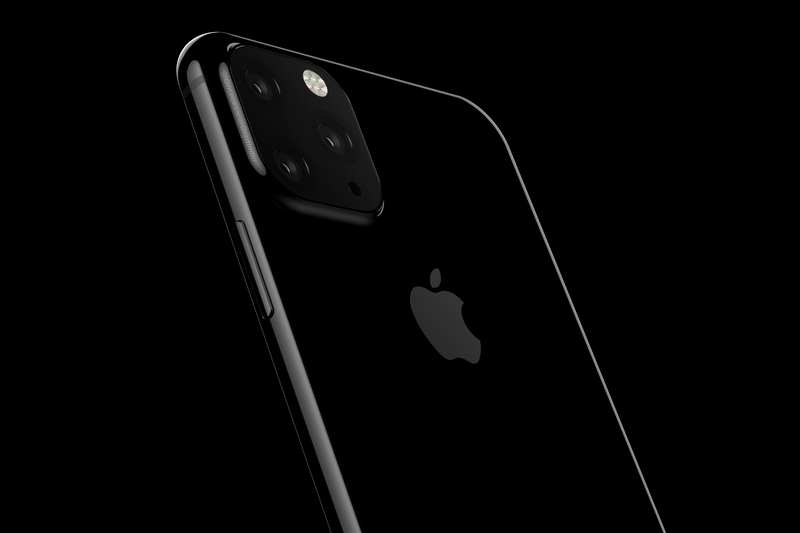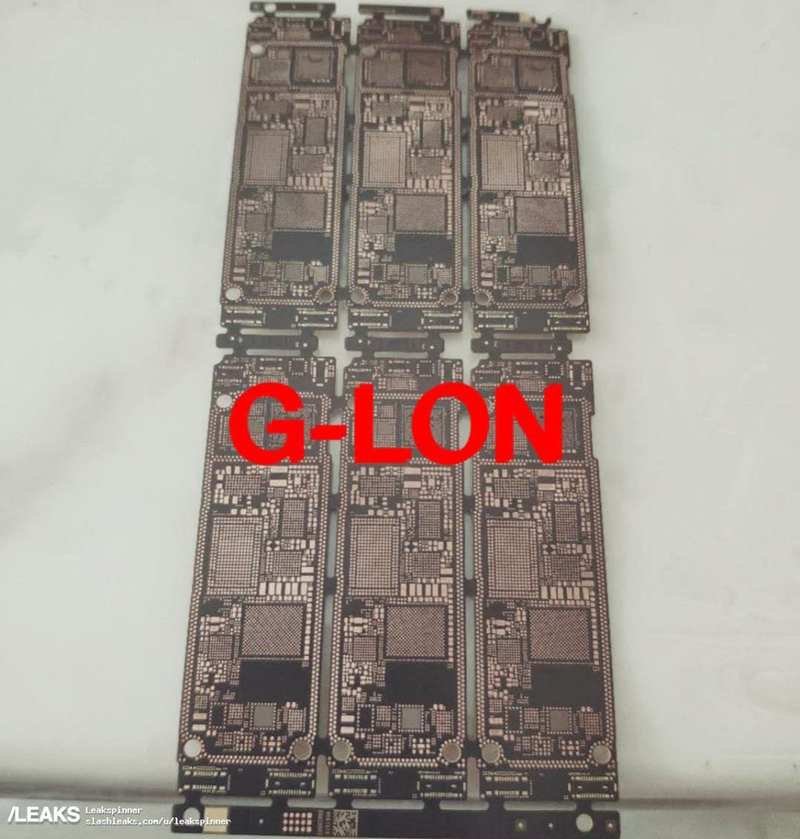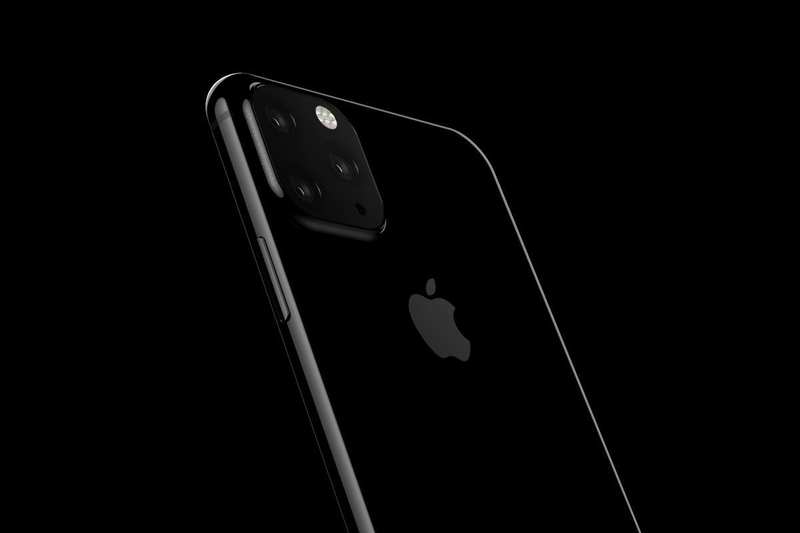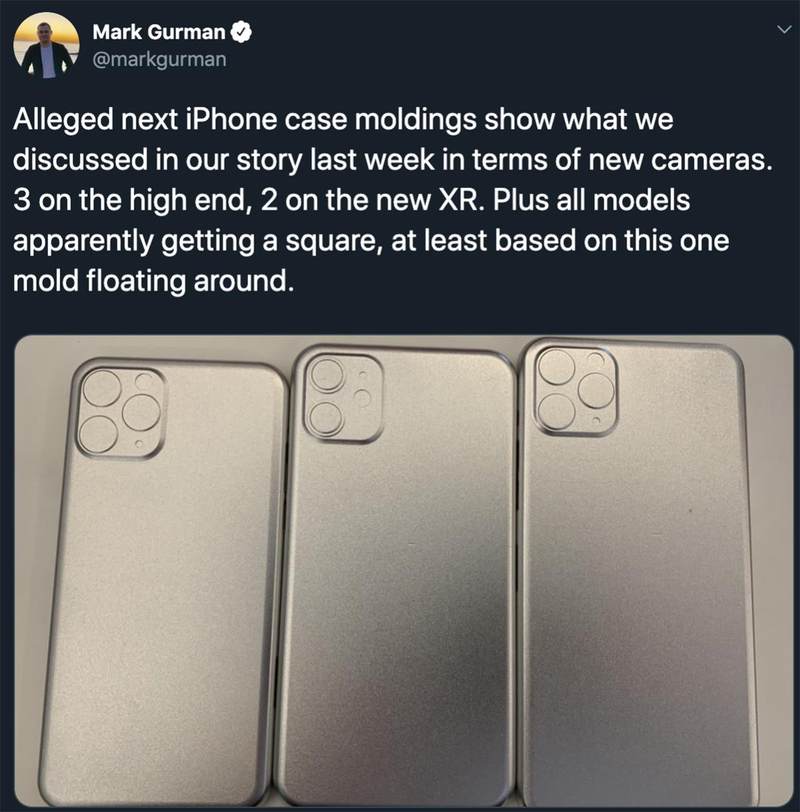iPhone 11 传闻:新款 iPhone 配备名为“Rose”或“R1”的传感器协处理器

What’s in store for the new iPhone in 2019? We won’t officially know until the fall (most likely in September), but until then, you can bet that the rumor mill will be fully operational. This page will keep track of what’s being rumored as new features of the 2019 iPhones, and we’ll provide some analysis and whether or not a rumor seems feasible.
Updated 09/09/19: A new rumor from MacRumors states that the 2019 iPhones have a new sensor co-processor code-named “Rose” or “R1.”
New ‘Rose’ or ‘R1’ sensor co-processor
Apple has used motion co-processors in the iPhone since the iPhone 5S in 2013. The first two (M7 and M8) were separate chips, but M9-M12 were integrated into the A-series processor. They process data from the accelerometer, gyroscope, compass, barometer, and even enable the microphone to listen for “Hey, Siri.” Basically, it’s custom circuitry to process sensor info in a very high-performance and low-power way, so it can be done even while the phone is in sleep mode.
According to a new report from MacRumors, the iPhone 11 will include a new sensor coprocessor that goes by the codenames “Rose” or “R1.” MacRumors has seen reference to it in code from an internal build of iOS 13. It supposedly performs a similar function to the M-series co-processors, only it processes data from many more types of sensors in order to get a more accurate picture of the phone’s position and orientation.
It adds support for an inertial measurement unit (IMU), which is like a gyroscope and accelerometer, some Bluetooth 5.1 features like Angle of Arrival and Angle of Departure, Ultra-Wideband (UWB), and even some camera tracking features.
The new capabilities are expected to be especially useful for the new Apple Tags product and augmented reality.
Three new iPhones coming in September
Bloomberg has a report on what Apple plans to announce during its September event, which has yet to be announced. According to Bloomberg, the featured products of the event are the “Pro” iPhones that will succeed the iPhone XS and XS Max, as well as a follow-up to the iPhone XR.
The list of the new features on the phones have been spinning through the rumor mill for months. They include the three-sensor camera on the Pro models with improvements to low-light and wide-angle still shots, as well as extensive video recording enhancements; Face ID with a wider field of view; A13 processors; reverse wireless charging; improved water resistance; and an outside matte finish instead of glossy.
Bloomberg also said that 3D Touch will be replaced by Haptic Touch, similar to what’s on the iPhone XR. The successor to the iPhone XR will have a second back camera for optical zoom and enhanced portrait mode.
5G will not be available on the new iPhones. This will be available in 2020.
A smaller Apple Pencil incoming?
File this one under Weird Last-Minute iPhone Rumors. Online retailer Mobile Fun is selling an iPhone 11 Pro case by Olixar with an interesting feature: a slot on the rear of the case for a smaller Apple Pencil. Normally we’d completely dismiss such a odd rumor as ridiculous, but there are a few reasons why we’re lending some credence to this one. For one, it’s already being sold, but more importantly, Mobile Fun has a decent track record of predicting phone designs before launch. Earlier this year, it nailed the Galaxy S10’s hole-punch design, and it was one of first to accurately predict that the Note 10 would be dumping the headphone jack. But this one is certainly going out on a limb. Not only does Olixar think the iPhone 11 Pro will have Apple Pencil support, it also think Apple will be making a shorter Apple Pencil for it.
Plausible: While we wouldn’t be surprised to see this rumor go up in smoke, it’s just crazy enough to be believable. If Apple is actually going to differentiate its flagship iPhone with the “Pro” moniker this year, it’s going to need something other than a bigger screen to justify it. Apple Pencil support would fill that need well, and the current Pencil isn’t exactly iPhone friendly, in that it’s taller than every model. So maybe a smaller Pencil that only works with the iPhone 11 Pro isn’t so crazy.
iPhone Pro
A random Twitter post about the next iPhone doesn’t usually rise to the level of plausibility, but CoinX’s 13 posts have been remarkably accurate. Not only did CoinX predict the return of the iPad mini, the weight of the iPhone XS Max, and the lack of a headphone jack on the latest iPad Pro, he also nailed the 2018 iPhone naming scheme. And now CoinX is claiming to know the name of Apple’s next top-of-the-line iPhone: iPhone Pro. Presumably this will pertain to the 6.5-inch model, but CoinX doesn’t specify in the cryptic tweet, which reads: “‘Pro’ for iPhone? Crazy naming schemes over the past few years.”
Plausible? We’re been hearing rumors about a supposed iPhone Pro for more years than we care to remember, so it’s pretty clear that Apple has been toying with the name for a while. Since rumors have suggested that the larger iPhone won’t include any additional features this year (other than the bigger screen, of course), we’re not sure what will give it “pro” status, but we’re definitely intrigued.
Improved Haptics
A report from 9to5Mac primarily reiterates the rumors we’ve heard before, with one significant new wrinkle: This year’s new iPhones will feature “a new type of Taptic Engine, known by the codename leap haptics.” It’s not known what the new features of this improved Taptic Engine would be. Apple is already one of the very few to use a linear resonant actuator for its haptics, which provide much greater fidelity than the eccentric rotating mass vibration motors used in so many other phones.
Plausible? Apple is introducing a new Core Haptics framework in iOS 13 to give third-party developers greatly expanded control over the Taptic Engine, which has thus far been quite limited. Introducing new, more advanced haptics hardware at the same time would be excellent timing. In fact, it seems reasonable to assume that Apple’s plans to introduce more advanced haptic hardware is the very reason it created a new developer framework for haptics.
No more 3D Touch
We’ve heard several rumors claiming that 3D Touch will be absent from all 2019 iPhones. The Wall Street Journal predicted as much back in January, and then analysts from Barclays “confirmed” it by talking with suppliers in May. The latest rumor comes from Digitimes in an article about the future sales of touch interface suppliers TPK Holding and General Interface Solution. It says the companies, “may see sales grow in the second half of 2019 though Apple may remove 3D touch sensors from all 2019 iPhone devices, according to industry sources.”
Plausible? 3D Touch has been a fixture of iPhones since its introduction in the iPhone 6s, but is missing from the more affordable iPhone XR. It’s said to be an expensive technology, and difficult to implement on larger displays, which is why we’ve never seen it on iPads.
We can’t help but notice that iOS 13 greatly expands the “Haptic Touch” feature used by the iPhone XR, where users just tap and hold for a second to get a context menu with a little haptic feedback. In the upcoming version of iOS, the most important features of 3D Touch are replicated by Haptic Touch. This makes us think it’s likely that Apple will get rid of this expensive technology that sometimes confuses users, and better unify touch interaction features across all iPhones and iPads.
A look at the logic board
Over on anonymous leaking site Slashleaks, there are a pair of images that claim to show the iPhone XI logic board (six of them, in fact).
The alleged logic board for one of the 2019 iPhone models.
Of course we don’t yet know if any of the phones will be called the iPhone XI, and we don’t know which particular model this is supposed to be a logic board for (there are three rumored models for this year, just as last year). The back side of these logic boards have not yet been printed, and the chips have not yet been bonded to it—we’re just looking at a single side of a mystery printed circuit board.
Plausible? Sure, these could be an iPhone PCB. Of the current models, only the iPhone XR has a rectangular circuit board like this; the iPhone XS and XS Max have L-shaped circuit boards. Therefore, this could be a look at the iPhone XR’s successor, or it could be an indication that the iPhone XS successors will use a rectangular logic board and therefore have a different internal layout. There just isn’t too much we can glean from this without the chips attached.
Case renders show camera bump, mute slider
Case maker Olixar is already offering preorders on a set of cases for the iPhone 11 Max (which may or may not be the name of the phone Apple introduces this fall). You can see them at the U.K. retail site MobileFun, where you’ll see rendered versions of the cases in rendered versions of the iPhone 11 Max.
Olixar thinks it knows what the next iPhone will look like.
There are a few items of note. One is the square camera bump, which after several rumors we have come to expect. The other is the somewhat smaller “notch” for the TrueDepth module—it could be smaller in the new iPhones, or this could be something of an optical illusion since we expect the iPhone 11 Max to be even bigger than the iPhone XS Max. Finally, eagle-eyed observers will note that the mute switch is a rounded slider that moves up and down, instead of the current switch that flips front-to-back.
Plausible? None of these details are far-fetched, but it’s highly unlikely that any case manufacturer has learned about the minutia of the next iPhone already. In order to have cases available right at launch, manufacturers make a best guess based on their contacts in the manufacturing and supply chain, tweaking the design with more precise CAD dimensions closer to launch. These sort of early renders from case makers often get small details wrong, with corrections made as we get closer to launch.
18-watt USB-C power adapter included
Stop me if you’ve heard this one before: Apple is finally going to ditch the pitiful little 5-watt USB power adapter in favor of an 18-watt USB-C power adapter.
That’s the latest rumor from Mac Otakara, who claims its information comes from Chinese suppliers. All three new iPhone models are said to include the same 18-watt USB-C adapter as does the new iPad Pro, but that doesn’t mean the iPhones will have USB-C ports. Instead, they’ll come with USB-C Lightning cables in place of the current USB-A Lightning cables.
Plausible? We want nothing more than for Apple to catch up to 2016 Android phones in providing decent power adapters in the box. For a few years, iPhones have been capable of charging much more quickly than the 5-watt in-box power adapter will allow.
But we’ve been burned before. The 18-watt USB-C power adapter was a prominent rumor for last year’s iPhones—there were even leaked photos!—and it never came to pass. It turns out the power adapter everyone was excited about was intended for the new iPad Pro. So call us hopeful but not optimistic.
Two-way wireless charging and a bigger battery
Analyst Ming-Chi Kuo, who’s forecasts on Apple products have been amazingly accurate, released a new supply chain report with some new predictions about the 2019 iPhone.
If you have the AirPods Wireless Charging Case, you may be able to charge it with the 2019 iPhone.
Kuo’s latest said that he expects the new iPhone to support two-way wireless charging—in other words, you can use the iPhone to charge other devices. For example, if you have AirPods with a wireless charging case, you can place the encased earbuds on the new iPhone, and the iPhone will charge the AirPods.
As a result of this feature, Kuo said that Apple plans to make the iPhone batteries bigger. The successor to the iPhone XS could have a battery that’s about 25 percent bigger, while the iPhone XS Max follow-up could see an increase of about 15 percent. The iPhone XR successor will see a smaller battery gain of about 5 percent.
Plausible? Android phones with two-way wireless charging have already hit the market, so the technology already exists and it doesn’t seem far-fetched for Apple to adopt it. When you consider the monster success of the AirPods and the recent release of the wireless charging case (and even the demise of AirPower), it seems fitting (and inevitable) that Apple would implement this feature.
Three-camera system (two on XR)
Earlier this year we saw a render that most people dismissed as a concept that would never see the light of day. The funky design showed an iPhone with a giant square bump in the top left corner that housed three cameras and an LED flash. It didn’t seem like something Apple would make.
Oft-accurate leaker Steve Hemmerstoffer (@onleaks), who posted the original render, has returned with a complete schematic of the rear case, which appears to leaves telltale holes for three cameras and a flash positioned in the same way as the earlier leak. In fact, Hemmerstoffer overlaid the original render on the schematic and it matches up nearly perfectly.
Back in January, a report by Bloomberg says that Apple is currently testing iPhones with a rear three-camera system that will be found on larger iPhone models.
The third camera will allow a larger field of view, a wider range of zoom, and the ability to capture more pixels. Apple is also working on a new version of Live Photos that are 6 seconds, a boost from the current 3 seconds.
Rumors of the 2019 iPhone using three cameras started in April 2018, though there wasn’t much detail as to how the three-camera system would work. A report by Digit featured leaked renders acquired by Steve Hemmerstoffer. The renders show the three rear cameras on the 2019 iPhone in a large square camera bump.
Leaked render of an iPhone with a rear three-camera system.
Steve Hemmerstoffer later released new renders of 2019 iPhone prototypes with a three-camera system. The renders, posted by CompareRaja, show the cameras centered in a horizontal orientation, instead of the vertical lineup in the corner.

CompareRaja and Steve Hemmerstoffer
New leaked renders show a horizontal rear three-camera system and a smaller front notch.
CompareRaja says that both sets of renders are “100% legit prototypes” and “nothing is set in stone yet.”
Hemmerstoffer further claims that the rear cameras will be 10 megapixels and 14 megapixels, instead of the current dual 12-megapixel setup. Presumably they will still be one wide-angle and one zoom. Details of the third sensor are unknown—it may be a camera sensor of unknown resolution and zoom or a depth sensor. The front-facing camera will also be upgraded from 7 megapixels to 10.
Prolific (and often accurate) Apple analyst Ming-Chi Kuo has published a new research note for investors in April, in which he makes a more detailed forecast about the upcoming iPhone cameras:
We forecast the camera upgrade will be one of the new 2H19 iPhone’s major selling points. Critical spec upgrades are as follows. (1) Rear cameras of 6.5-inch OLED, 5.8-inch OLED, and 6.1-inch LCD will likely upgrade to triple-camera and dual-camera, respectively. A super-wide camera will be newly adopted by the triple-camera system, which is equipped with the 12MP/1um CIS provided exclusively by Sony. (2) The front camera of all three new iPhone models will likely upgrade to 12MP CIS+5P lens (vs. current 7MP CIS+4P lens).
So according to Kuo, OLED-sporting iPhones will get a third, super-wide 12 megapixel camera with sensor from Sony, and the iPhone XR equivalent will move to the two-camera system you find on the high-end iPhones today (with a telephoto lens).
The front cameras on iPhones are part of the TrueDepth module, and it looks like the main color RGB camera in that module is getting an upgrade from 7 megapixels with 4 lens elements to 12 megapixels with 5 lens elements.
Kuo further claims that the front camera and the new super-wide rear camera will be coated in a special black coating, which will help make the cameras harder to see and blend in with the rest of the phone.
In May, Mark Gurman tweeted an image of a trio of alleged case moldings that reinforces the square camera bump rumor. It shows even the XR replacement with a square camera bump, though it has two cameras instead of three.
A report from 9to5Mac in July claimed that the front camera on the new iPhones would support slo-mo video recording up to 120fps.
Plausible? If Apple’s going to continue to compete in the smartphone camera quality arms race, it’s going to need two things: An additional rear camera, and even more advanced computational photography. It feels like a triple-lens rear camera, at least on the higher-end models, is a given at this point. All that remains is to find out details about the camera placement and arrangement, specifics of sensors and optics, and advances in Apple’s photography software.
A13 processor
A report from DigiTimes states that the 2019 iPhone will have a processor “dubbed the A13.” It’ll be a 7-nanometer CPU manufactured by Taiwan Semiconductor Manufacturing Company.
A report from Bloomberg in May said that TSMC entered test production of the chip in April, and that full production was imminent. That’s about the expected production schedule for a fall release of the completed iPhone.
[We have our own predictions about what we can expect from Apple’s A13 chip. Read about that here.]
Plausible? DigiTimes reports aren’t always reliable, but this one makes sense logically—Apple’s new top-of-the-line phones usually have new processors. The current CPU in the iPhone XS is the A12 Bionic and it was the first 7nm processor, so the report that the A13 will also be 7nm seems legit.
iPhone XR may get dual-camera system
While Tim Cook himself has all but admitted the iPhone XR isn’t selling nearly as well as he hoped it would, it seems like Apple isn’t ready to give up on it just yet. The Wall Street Journal reports that Apple will be sticking with the three-model lineup in 2019, with the LCD iPhone XR once again anchoring the low end. The publication says an all-OLED family could be in store for 2020. However, there will be one notable improvement: the XR will reportedly be receiving a dual-camera setup to match the one in the iPhone XS, while the XS Max receives the new triple-camera array.
Plausible? Definitely. The iPhone XR is one of the best phones Apple has ever made, and it would be crazy to outright kill it after just one cycle. In addition to the extra camera, Apple likely has some other refinements, but the question we have is: How will Apple differentiate it between the XS? The camera setup was by far the biggest difference between the two models, so if Apple takes away that advantage, what benefit do buyers have to spend an extra $250 (or whatever it costs next year) on the XS?
Smaller notch
The notch on the iPhone screen not only serves a functional purpose, but it also gave the iPhone a look that was instantly recognizable (at least until other companies copied it). But if the rumors are accurate, don’t expect the notch to be a longtime characteristic of the iPhone.
AMS, a sensor manufacturer, announced that it has created a new optical sensor that can “accurately measure the intensity of ambient light from behind an OLED screen.” According to Reuters, Apple uses AMS optical sensors for 3D facial recognition in the iPhone, so it’s not that far of a reach to think that Apple would want to use AMS’s new TCS3701 Color and Proximity Sensor in the next iPhone. This could result in a much smaller notch, or perhaps no notch at all.
AMS rendering of how its new sensor can eliminate the notch on smartphones.
Plausible? Apple and AMS have an established relationship (Reuters says that Apple accounts for 45 percent of AMS’s business), and rumors that Apple has been looking to shrink or eliminate the notch have been out for a while.
But the ambient light and proximity sensors are two of the smallest parts of the TrueDepth module that constitutes the iPhone’s notch. Far larger are the traditional front camera, the infrared front camera, the speaker, and the infrared dot emitter. In order to make the notch noticeably smaller, Apple would need to combine or eliminate some of those elements. Given their current placement, simply moving the proximity sensor and ambient light sensor underneath the OLED display, as per this rumor, wouldn’t do much at all.






